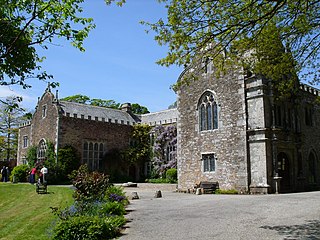
Beaumanor Hall is a stately home with a park in the small village of Woodhouse on the edge of the Charnwood Forest, near the town of Loughborough in Leicestershire, England. The present hall was built in 1842–8 by architect William Railton and builder George Bridgart of Derby, for the Herrick family, with previous halls dating back to the 14th century, and is a Grade II* listed building It was used during the Second World War for military intelligence. It is now owned by Leicestershire County Council as a training centre, conference centre and residential facility for young people.

Belgrave Hall is a Queen Anne-style Grade II* listed building in Belgrave. It is located on the northern edge of the city of Leicester.

Brocton Hall is a building of historical significance and is listed on the English Heritage Register. It was built in 1760 by William Chetwynd and remained in the Chetwynd family until 1923 when it was sold to the Golf Club. Today the building is still used as a clubhouse and is also a venue for weddings.
Thomas Paget was a banker and Whig politician in England.

Harry Grey, 4th Earl of Stamford was an English peer, styled Lord Grey from 1720 to 1739.
Sir Hercules Underhill (1581–1658) was the son of William Underhill of Warwickshire, owner of New Place in Stratford-Upon-Avon. William Underhill sold New Place to William Shakespeare in 1597, and Hercules Underhill confirmed the sale in 1602.

Debden House is a conference centre and campsite located in Loughton, Essex, England. The house is owned and operated by Newham London Borough Council.
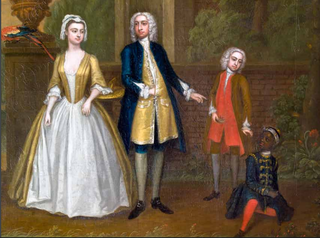
Edward Southwell, 20th Baron de Clifford was a British politician.
John Archer-Houblon of Welford Park and Hallingbury Place was a British Member of Parliament.
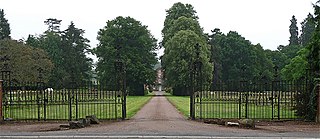
Henley Hall is a building of historical significance and is listed on the English Heritage Register. It was built in about 1610 by the Powys family and then substantially changed in 1772. Additions were again made in the late 19th century. It is a generally a three-storey building in brick with a slate roof. Flanking wings were added at both ends of the original linear building c. 1772 and further major extensions carried out in 1875 and 1907. The hall is surrounded by landscaped and formal gardens covering some 60 hectares. The hall itself is listed grade II* and the orangery, outbuildings, dovecote and Bitterley main gate are listed Grade II. It is situated 2.5 miles (4.0 km) northeast of Ludlow town centre, just off the A4117 road to Cleobury Mortimer. The Ledwyche Brook flows by the estate.

Lowesby Hall is a large Grade II* Georgian mansion in the parish and former manor of Lowesby, eight miles east of Leicester in Leicestershire. It is a famous fox-hunting seat in the heart of the Quorn country. The poem "Lowesby Hall" by the Victorian English foxhunting MP William Bromley Davenport (1821–1884) was a parody of Alfred Tennyson's 1835 poem Locksley Hall.
William Archer, of Coopersale, in Theydon Garnon, Essex, and Welford Park, Berkshire, was an English lawyer and Tory politician who sat in the House of Commons from 1734 to 1739.
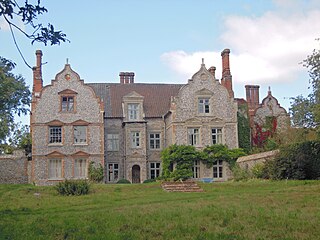
Wiveton Hall is a country house in Wiveton, Norfolk, England. It is Grade II* listed. It was built in 1652 and extended in 1908. However there are remains of an older building in the garden which could date back to 1280. It was the residence of many notable people over the next three centuries and is now the home of the MacCarthy family. The Hall provides holiday cottage accommodation, a restaurant café, a farm and gift shop and has garden tours. The West Wing is available for weddings and other special events.
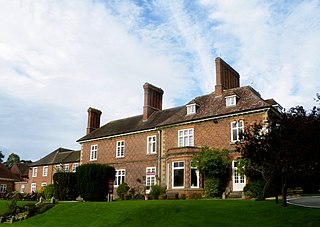
Albrighton Hall near Shrewsbury, Shropshire, is a house which is Grade II* listed on the National Heritage List for England. It was built in 1630 for the Ireland family and remained in this family for the next five generations until 1804. It was then the home of several notable people until 1953. In the 1990s it was converted into a hotel.

Horsforth Hall Park is a large community park in Horsforth, West Yorkshire, England, approximately six miles from Leeds city centre.
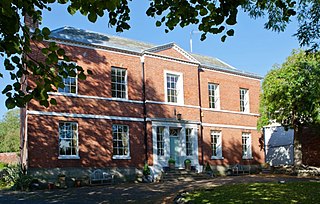
Breedon Hall, Breedon on the Hill in north-west Leicestershire, is a house of historical significance and is listed on the English Heritage Register. In 1620 it was a small timber-framed cottage. Soon after it was bought by the Curzon family and was successively enlarged until 1777 when it was given a new Georgian front. It was the ancestral home of the Curzons for over three centuries and then bought by the Shields family. Today it is owned by the Meynell family and provides bed-and-breakfast accommodation.
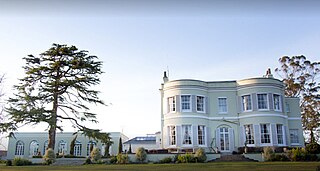
Deer Park Country House near Honiton, Devon is a house of historical significance and is Grade II listed on the English Heritage Register. It was built in the early 1700s by a wealthy landowner and was the home of many notable people over the next two centuries. Today it is a venue for special events including conferences and weddings.

Hopwell Hall country house near Ockbrook, Derbyshire was built in 1720. It was owned by five generations of the Pares family from 1786 to 1921. The hall was demolished after a fire in 1957.
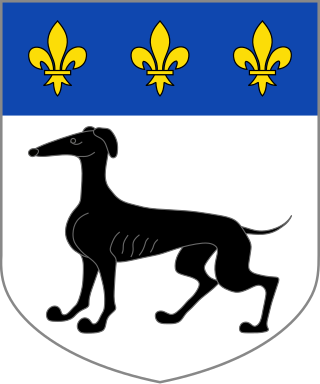
The Halford baronetcy of Wistow, Leicestershire, was created in 1641 for Richard Halford in the Baronetage of England. It became extinct in 1780 with the death of the seventh and last baronet.














